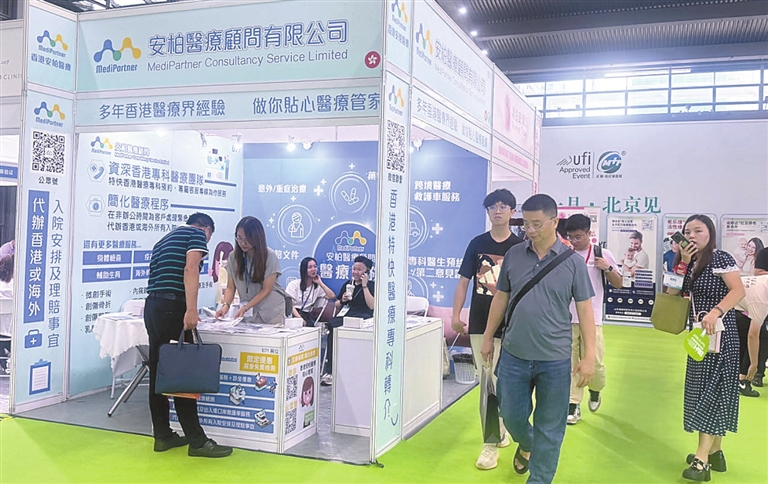

Windy Shao windysjf@hotmail.com THE recent opening of the Shenzhong (Shenzhen-Zhongshan) Link and the increased frequency of high-speed trains connecting cities within the Guangdong-Hong Kong-Macao Greater Bay Area (GBA) have ushered in a new era of convenience, creating a “one-hour living circle” for residents. For people living in Hong Kong, a one-day tour including a morning visit to a Shenzhen medical institute followed by afternoon sightseeing in Zhongshan has become a reality, attendees said at a seminar during the International Medical Tourism Exhibition Fair held at the Shenzhen Convention and Exhibition Center in Futian District earlier this month. Medical professionals from across the GBA convened at the seminar July 12 to deliberate the boundless prospects and challenges presented by the evolving landscape of the region. Organizers of the seminar highlighted the limitless potential for medical tourism, noting the significant demand for treatment of suboptimal health, cancer, and infertility. Additionally, the demand for anti-aging regenerative therapies is growing as the aging population increases. Disparities in medical expertise, service quality, and pricing between different regions have spurred a growing interest in cross-border medical services among consumers in the GBA. Ren Hua, chief medical officer of Shenzhen New Frontier United Family Hospital, noted the collaborative strengths of different cities within the GBA in enhancing medical resource connectivity. Guangzhou is synonymous with high-level medical care, Hong Kong excels in internationalized services, and Shenzhen leads in research and development capabilities, he said. Ren shared that his hospital has witnessed a steady increase of patients from Hong Kong in recent months. Premium healthcare hub Shenzhen has witnessed a surge in medical tourism in recent years, drawing in a substantial number of Hong Kong residents seeking treatment. Renowned for its relatively low private medical costs compared to Hong Kong, the city has become a preferred destination for medical services including dental care, ophthalmology, orthopedics, and traditional Chinese medicine. One Hong Kong patient told ifeng.com that he chose to undergo hernia surgery at a private hospital in Shenzhen due to its affordability and prompt services, a contrast to the lengthy wait times experienced at public hospitals in Hong Kong. Statistics from the Shenzhen Municipal Public Hygiene and Health Commission showed that around 770,000 overseas patients sought medical care in Shenzhen in 2023. Of them, 640,000 came from Hong Kong and Macao. Premier healthcare institutions like the Hong Kong University-Shenzhen Hospital (HKU-SZH), Shenzhen People’s Hospital, and Luohu District People’s Hospital have emerged as preferred choices for overseas patients. HK initiatives The growing number of Hong Kong patients seeking cross-border medical treatment has been driven by two significant initiatives introduced by the Hong Kong government. The first initiative, the Elderly Health Care Voucher (EHCV) Scheme, aims to provide elderly residents with financial assistance for healthcare needs. The scheme offers eligible Hong Kong residents aged 65 and above an annual subsidy of HK$2,000 (US$256), with a total limit of HK$8,000, each to help them access primary healthcare services that cater to their specific health requirements at designated hospitals in the GBA. The second one — the Elderly Health Care Voucher Pilot Reward Scheme — acts as a supplementary program that encourages elderly individuals to embrace healthy lifestyle choices. It provides subsidized medical services for Hong Kong residents living in the GBA at select mainland facilities. Under this scheme, eligible Hong Kong patients are only required to pay 100 yuan (US$13.8) for medical services valued at 2,000 yuan or less. As of February this year, data from HKU-SZH showed that over 4,000 eligible patients have participated in the pilot scheme at the hospital. In response to inquiries from the Hong Kong Legislative Council, the Hong Kong Department of Health reported that Hong Kong residents have used EHCV Scheme vouchers totaling HK$34.935 million at HKU-SZH between 2021 and 2023. Medicine Connect The Medicine Connect program is another initiative that has encouraged more patients from Hong Kong and Macao to seek medical services at mainland hospitals. China launched the pilot program in 2021 to provide GBA residents access to imported medicines and devices, thereby aligning regional practices with global standards. Initially, five mainland medical institutions in Guangzhou, Shenzhen, Zhuhai, and Zhongshan were included in this program. By February 2023, the number of hospitals authorized to import new drugs and devices from Hong Kong and Macao had increased to 19, according to the Health Commission of Guangdong Province. However, some professionals at the seminar expressed concerns about the sustainability of the program, citing potential pressure on hospitals. Dr. Huang Zhihao, chief executive officer of Zhongshan Chen Xinghai Hospital, noted that while hundreds of patients at his hospital had benefited from the program, the compliance procedures it requires are labor- and resource-intensive. He recommended streamlining procedures and involving more Hong Kong professionals in supervising the use of imported medicines. | 
